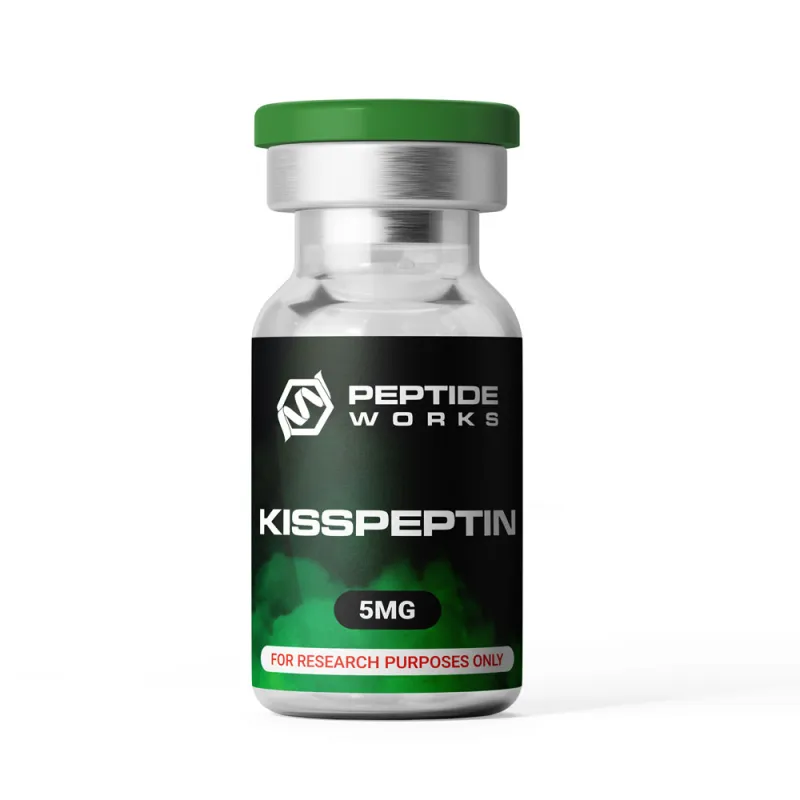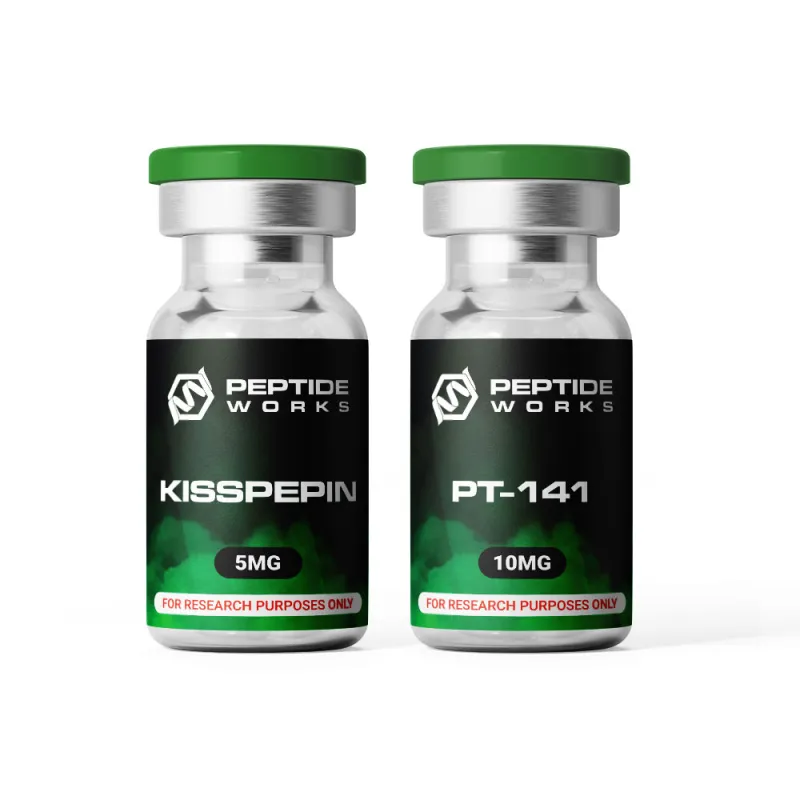
PROMO!
First order? Get 10% OFF with this code: 1storder
Written by

Peptides play an important role in fertility research. Two that often stand out are PT-141 and Kisspeptin. Each acts on the body in a different way, yet both connect to the broader study of reproductive health.
PT-141, also known as bremelanotide, is recognized for its impact on sexual arousal through brain pathways that involve the brain’s melanocortin receptors. Kisspeptin, on the other hand, is a natural peptide that controls how the brain releases GnRH, the hormone that starts the chain of fertility signals and influences hormone balance.
When we compare PT-141 vs Kisspeptin, the picture shows two different but linked paths. PT-141 research focuses on sexual behavior and arousal, including its potential relevance in hypoactive sexual desire disorder and other sexual problems research. Kisspeptin research looks at hormone balance and fertility control. Together, they provide a fuller view of how peptides may shape the future of reproductive studies.
Because Kisspeptin is tightly linked to GnRH, understanding this connection helps explain how fertility signals begin.
Explore PT-141 from Peptide Works, a synthetic peptide studied for its effects on the melanocortin system, influencing libido and sexual motivation in research.

Kisspeptin plays a central role in fertility by stimulating the brain to release GnRH. This hormone controls the rhythm of the reproductive cycle and drives the release of LH and FSH. Without these signals, ovulation may not occur in women, and sperm production can be disrupted in men. For this reason, Kisspeptin is widely studied in reproductive medicine.
Clinical trials show Kisspeptin can trigger an LH surge strong enough to induce egg maturation, which is why it has been tested in IVF treatments for premenopausal women. In the discussion of PT-141 vs Kisspeptin, this sets Kisspeptin apart: it acts on the hormonal axis itself, while PT-141 is studied for its effect on sexual function and arousal.
Since GnRH plays such a pivotal role, its broader function helps connect the chain of fertility signals.
In laboratory research, GnRH controls the release of LH and FSH, the two hormones that drive reproductive processes. Pulses of GnRH act like a timer, setting the rhythm for ovulation and sperm development. Because Kisspeptin stimulates these signals, scientists often study the two together to understand the chain of events that regulates sexual response and fertility.
When looking at PT-141 vs Kisspeptin, the difference becomes clearer through GnRH. Kisspeptin connects directly to hormonal release, while PT-141 is studied for its influence on brain regions tied to arousal and psychological factors affecting sex drive, including aspects of mental health. This contrast shows why researchers explore them side by side in reproductive science.
These downstream hormones, LH and FSH, directly influence testosterone levels and erectile function, making them important to examine in detail.
Discover Kisspeptin from Peptide Works, a natural peptide linked to the GnRH axis and widely studied for its role in regulating fertility hormones like LH and FSH.

LH and FSH are gonadotropins that control egg growth, ovulation, and sperm production. FSH supports follicle development and sperm formation, while LH triggers hormone release needed for ovulation and testosterone regulation. Researchers often track the LH/FSH ratio in studies because imbalances can signal disrupted fertility or low libido in both men and women.
In peptide research, this distinction links directly to the debate of PT-141 vs Kisspeptin. Kisspeptin stimulates GnRH, which regulates LH and FSH, making it central to hormone control studies. PT-141 instead works through specific receptors in the central nervous system tied to sexual performance. By focusing on hormone endpoints, scientists can see how Kisspeptin drives fertility signals in ways PT-141 does not.
While Kisspeptin is tied to hormone signaling, PT-141 has gained attention for its role in libido, which adds another dimension to reproductive studies.
PT-141 may enhance libido by activating melanocortin-4 receptors (MC4R) in the brain, making it a peptide of interest in studies involving sexual desire disorder. In animal studies, stimulating these receptors increased sexual motivation and erectile responses, which are key indicators often studied in cases of erectile dysfunction or erection issues, even when hormone levels like LH and FSH did not change. This shows that PT-141 acts on neural circuits linked to arousal and penile erection, rather than the hormone axis that drives ovulation or sperm development.
This distinction becomes clear when comparing PT-141 vs Kisspeptin. Kisspeptin initiates GnRH release to regulate fertility hormones, while PT-141 works through central signaling that shapes desire and arousal, highlighting how mental health and neural activation intersect in sexual motivation research. Together, these peptides highlight two complementary paths in reproductive science, one based on hormonal control, the other on brain-driven libido pathways that may indirectly influence nitric oxide signaling.
Bringing both peptides into direct comparison helps researchers see how they complement one another in fertility and reproductive health.
When comparing fertility peptides, PT-141 and Kisspeptin show very different pathways. Kisspeptin directly activates the GnRH hormone axis, which controls LH and FSH, the hormones that regulate ovulation and sperm development. PT-141, on the other hand, works through melanocortin-4 receptors (MC4R) in the brain, where it increases sexual desire and arousal, making it an important subject in sexual disorders research. This difference highlights how one peptide drives fertility signals through hormones, while the other influences reproductive behavior through neural circuits.
The relative impact of each peptide on fertility and reproductive health depends on the context of the study. Kisspeptin is more closely tied to hormone balance and fertility regulation, while PT-141 is linked to libido and arousal pathways. Both provide unique insights, and comparing them side by side shows why they are often studied together.
| Peptide | Main Pathway | Role in Fertility & Reproductive Health |
|---|---|---|
| PT-141 | Melanocortin-4 receptors (MC4R) | Boosts libido and arousal; indirect link to reproductive behavior |
| Kisspeptin | GnRH → LH & FSH hormone axis | Regulates ovulation, sperm production, and overall hormone balance |
| Key Difference | Neural signaling vs hormonal control | PT-141 influences desire; Kisspeptin drives fertility hormones |
With the differences between PT-141 vs Kisspeptin in mind, researchers also consider whether combining them in a single stack could reveal deeper insights.

Researchers explore the PT-141 and Kisspeptin Stack because it combines two different mechanisms. Kisspeptin stimulates the GnRH axis, which controls fertility hormones such as LH and FSH. PT-141 activates melanocortin receptors in the brain, boosting signals linked to sexual activity and arousal. Together, this stack connects hormone regulation with libido pathways, giving researchers a broader view of how peptides may influence reproductive systems affected by hormonal imbalances or psychological factors.
This combination also allows researchers to examine how the vascular system and hormone communication respond to both central and hormonal signals, especially in reproductive health conditions, expanding understanding of the human body’s integrated sexual performance mechanisms.
Shop PT-141 and Kisspeptin Stack from Peptide Works, a research peptide combination that connects libido pathways with hormone regulation for deeper reproductive studies.
The future of fertility peptides looks promising as research expands into how different pathways shape reproductive health. Studies on PT-141 vs Kisspeptin show that Kisspeptin drives the hormonal axis through GnRH, while PT-141 works on brain receptors tied to libido and sexual motivation.
Both reveal unique insights, and when studied together as a PT-141 and Kisspeptin Stack, they highlight the link between hormone balance and arousal pathways. Ongoing trials and further activity in this field continue to expand the understanding of fertility, libido, and neural-hormonal interaction
Peptide Works provides PT-141, Kisspeptin, and stack options strictly for research use. We support labs and researchers and actively advance studies that examine how reproductive systems respond to hormonal control and central signaling, driving the next wave of discoveries in fertility and reproductive health.
All products discussed are supplied for research purposes only and are not intended for human use.
[1] Molinoff PB, Shadiack AM, Earle D, Diamond LE, Quon CY. PT-141: a melanocortin agonist for the treatment of sexual dysfunction. Ann N Y Acad Sci. 2003 Jun;994:96-102.
[2] Rosen RC, Diamond LE, Earle DC, Shadiack AM, Molinoff PB. Evaluation of the safety, pharmacokinetics and pharmacodynamic effects of subcutaneously administered PT-141, a melanocortin receptor agonist, in healthy male subjects and in patients with an inadequate response to Viagra. Int J Impot Res. 2004 Apr;16(2):135-42.
[3] Anderson D, Laforge J, Ross MM, Vanlangendonck R, Hasoon J, Viswanath O, Kaye AD, Urits I. Male Sexual Dysfunction. Health Psychol Res. 2022 Aug 20;10(3):37533.
[4] Qin L, Sitticharoon C, Petyim S, Keadkraichaiwat I, et al. Roles of kisspeptin in IVF/ICSI-treated infertile women and in human granulosa cells. Exp Biol Med (Maywood). 2021 Apr;246(8):996-1010.
[5] Stoléru S, Redouté J, Costes N, Lavenne F, Bars DL, Dechaud H, Forest MG, Pugeat M, Cinotti L, Pujol JF. Brain processing of visual sexual stimuli in men with hypoactive sexual desire disorder. Psychiatry Res. 2003 Oct 30;124(2):67-86.
[6] Jaafarpour M, Khani A, Khajavikhan J, Suhrabi Z. Female sexual dysfunction: prevalence and risk factors. J Clin Diagn Res. 2013 Dec;7(12):2877-80.
[7] Meyers M, Margraf J, Velten J. Psychological Treatment of Low Sexual Desire in Women: Protocol for a Randomized, Waitlist-Controlled Trial of Internet-Based Cognitive Behavioral and Mindfulness-Based Treatments. JMIR Res Protoc. 2020 Sep 29;9(9):e20326.
[8] Shahhosseini Z, Gardeshi ZH, Pourasghar M, Salehi F. A review of affecting factors on sexual satisfaction in women. Mater Sociomed. 2014 Dec;26(6):378-81.
ALL CONTENT AND PRODUCT INFORMATION AVAILABLE ON THIS WEBSITE IS FOR EDUCATIONAL PURPOSES ONLY.
DISCLAIMER: These products are intended solely as a research chemical only. This classification allows for their use only for research development and laboratory studies. The information available on our Peptide Works website: https://peptide-works.com/ is provided for educational purposes only. These products are not for human or animal use or consumption in any manner. Handling of these products should be limited to suitably qualified professionals. They are not to be classified as a drug, food, cosmetic, or medicinal product and must not be mislabelled or used as such.
Peptide Works
Related Articles

How effective could Orexin Addiction Therapy be?
Have you ever wondered why some people find it so hard to stop addictive habits, even when they truly want

Can NAD Therapy Improve Cognitive Performance?
NAD Therapy is gaining attention in research for its possible role in brain health. NAD+ (nicotinamide adenine dinucleotide) is a

Enhancing Energy with NAD+ Supplements
Energy is the driving force behind focus, movement, and recovery. When cells have less energy to work with, the body